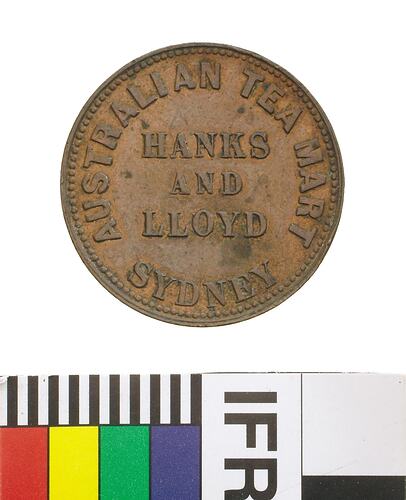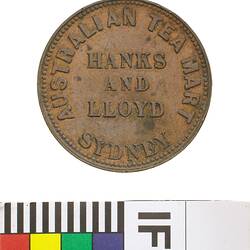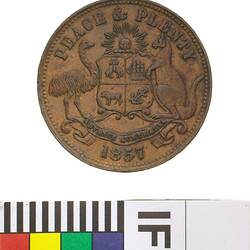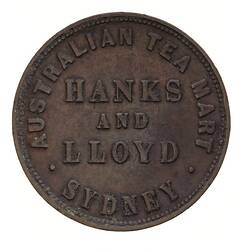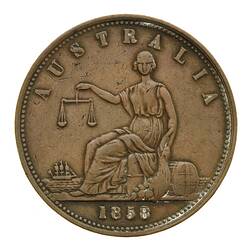Summary
Copper Halfpenny Token, minted by W.J. Taylor, London. Issued by Hanks & Lloyd, Australian Tea Mart, Sydney, 1857. J.G. Hanks joined A. Lloyd to open a business in 1855. The same year Hanks and Lloyd must have received their first tokens, as the partners used them as commemoratives for the opening of the first Sydney Railway in1855, an excellent publicity opportunity. In 1858 the company had changed name, becoming Hanks & Co. It seems that Lloyd was still participating in the business, but he had always been the junior partner.
Previous Collections: National Gallery of Victoria
Physical Description
A round copper token (28 mm dia) featuring the name, address and business of the issuing company Hanks & Lloyd Sydney Tea Market. The Hanks and Lloyd halfpenny token orders employed three obverse and two reverse dies. The reverses are either dated 1855 or 1857 but the obverse die identification is based on the length of the word HANKS together with the number of border dots. In this case: The obverse has 110 dots around the rim and HANKS is 12.8 mm long. The reverse is dated 1857.
Obverse Description
At centre, HANKS / AND / LLOYD; around, AUSTRALIAN TEA MART . SYDNEY .
Reverse Description
Arms of New South Wales; above, PEACE & PLENTY; below, 1857 on ribbon below Arms, ADVANCE AUSTRALIA
Edge Description
Plain
More Information
-
Collecting Areas
Numismatics & Philately, Sustainable Futures, Working Life & Trades
-
Acquisition Information
Transfer from National Gallery of Victoria (NGV), 15 Mar 1976
-
Date Issued
1857 AD
-
Issued By
Hanks & Lloyd, Sydney, Greater Sydney, New South Wales, Australia, 1855
-
Mint
-
Previous Collection
Numismatics Collection, National Gallery of Victoria (NGV), pre 1976
-
Inscriptions
Obverse: HANKS AND LLOYD AUSTRALIAN TEA MART SYDNEY Reverse: PEACE & PLENTY 1857
-
Denomination
-
Series
-
Material
Copper
-
Axis
12
-
Classification
-
Category
-
Discipline
-
Type of item
-
Dimensions
28 mm (Outside Diameter), 7.358 g (Weight)
-
Shape
Round
-
References
The Hanks and Lloyd halfpenny token orders employed three obverse and two reverse dies. The reverses are easy to identify as they are either dated 1855 or 1857 but the obverse die identification is based on the length of the word HANKS together with the number of border dots. Neither dies employed in 1855 were carried forward to the 1857 striking, but two new obverse dies were employed that year. In this case: The obverse has 110 dots around the rim and HANKS is 12.8 mm long. For the second obverse die see NU3822
[Book] Andrews, Arthur. 1921. Australasian Tokens and Coins., No. 194
[Book] Heyde, Gilbert C. & Skinner, Dion H. 1967. Unofficial Coins of Colonial Australia and New Zealand., No. 98/2
-
Keywords
